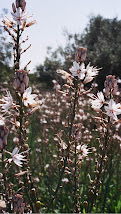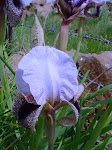What a delight it has been searching for and photographing our wonderful wild flowers. 2700 species in Israel so I have hardly scratched the surface.
I am not an expert photographer but my amazing digital camera makes me seem like one.
Four thousand years ago a man named Abraham left his birth-place and wandered far until he came to a difficult but beautiful land. His family grew and became a people. The land was their home-land. We are that people, the Jewish people and our home-land is the Land of Israel. With Bible in hand we can walk The Land and feel the connection to our ancestors.
....
Fritillaries always seem so very fragile to me.
They look like ethereal bells dancing on delicate stalks. And yet here they are growing wild and blooming in profusion. Quite amazing!
These flowers were photographed somewhere between Cochav Hayarden and Har Tavor, one glorious spring day.
____________________________________
The evening primrose Oenothera drummondii is a joy to see – not least because it is one of the few plants to flower in the fierce Israeli summer.
It gives even more delight when it blooms throughout the night. It’s Hebrew name, ner halayla, means candle of the night. This lovely flower was not mentioned in Bible times – but has flourished in Israel since the 19th century.
It seems it came from the Americas – perhaps a stubborn seed clung to a pioneer’s boot. Like those early pioneers it is a survivor, stubbornly growing in places no other flowers can. It tolerates the saltiness of the sea-shore, the aridness of the sand, and the spray of the waves.
Look closely at the flower to see an unusual feature – the cross shaped stigma.
The plant is fertilised by a moth, not surprising as its flowers open at night – and when I say open at night I mean a tightly closed bud will open within about 30 seconds! One plant can have between 20 and 30 flowers open over-night and they will simply fade away by noon next day, to be replaced the next night by as many more.
Growing with the evening primrose was the equally beautiful sea daffodil, pancratium maritimum, which in Hebrew is called Chavatzelet HaChof. Many people believe that this native plant is the Chavatzelet HaSharon mentioned in King Solomon’s Song of Songs. Chof being sea-shore and the Sharon Plain being along the coast this would fit. For some reason the chavatzelet was mis-translated as rose. The Hebrew word for bulb is batzal so this is likely to be the root of the name (no pun intended!)
The sea daffodil is sometimes called the sand lily - whatever its name, it is a beautiful flower whose delicate look belies its toughness as it to thrives in the arid waste-lands of the sea-shore.
Whatever order you see them in, they always uplift the spirits!
Check out wild poppies growing in urban Tel Aviv at the end of March.http://www.youtube.com/watch?v=w21aL1Wha4o



What a delight it has been searching for and photographing our wonderful wild flowers. 2700 species in Israel so I have hardly scratched the surface.
I am not an expert photographer but my amazing digital camera makes me seem like one.















I have promised and I have prevaricated.
Now I am coming through - I am writing the book.
As a tour guide, I love
As a nature lover I love our fabulous wild flowers.
As a proud Israeli I love the connection to our history.
Proud to be Jewish, I love the connection between the land and the bible (Ha’aretz vha’tenach).
There you have it.
My idea.
My book.
You can see the glorious blooms, read the stories, ponder the meanings.
Flora, faith and folklore from the Land of the Bible.
With your encouragement I might even get this project done!

Hi, Pamela, the book is going to be great! I have been in love with the archeology of theBible but to see those beautiful flowers makes me realize how little I know about the flora of the Holy Land. Jesus talked about the lilies of the field and how they were more beautiful than Solomon in all his splendor, looking at the irises, I can see what He meant. I know a lot of people who will be interested in your project.
ReplyDelete